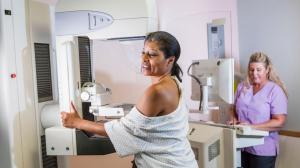Date Posted, by DCP Staff
This month’s Research Highlights focuses on provider and patient beliefs about mammogram screening frequency, and separately, provider barriers to engaging in shared decision-making with high-risk patients about the use of chemoprevention to reduce breast cancer risk. Both studies discuss the value of and barriers to using decision-support tools designed to help in the delivery of optimal preventive care.
Study Assesses Common Beliefs on Mammogram Frequency
How often should women get mammography screening? The answer depends on who you ask. The American College of Physicians and the U.S. Preventive Services Task Force (USPSTF) recommend screening for women every other year (biennially) after age 50, while the American College of Radiology and the American College of Obstetricians and Gynecologists recommend annual screening.
Although annual screening allows breast cancer to be diagnosed at earlier stages, over-screening can result in harms such as increased patient anxiety from abnormal mammograms, unnecessary biopsies for benign lesions, and increased surgical procedures with no proven benefit in extending life.

To better understand current mammography screening practices and beliefs, Columbia University researchers interviewed 25 women undergoing screening mammograms, 11 primary care providers (PCPs), and eight other key stakeholders (breast radiologists, radiology administrators, and patient advocates).
These stakeholders held “divergent views about optimal mammogram screening frequency resulting in general uncertainty,” according to the researchers. “For example, radiologists recommended annual mammograms, consistent with their society guidelines, whereas patients and PCPs were split between annual versus biennial screening, although both favored annual screening among women at higher risk.”
The researchers wrote that “breast cancer risk assessment tools may help facilitate decisions about screening intervals, but face barriers to widespread implementation in the primary care setting, including time burden, clinicians’ unfamiliarity with using risk calculators to guide cancer screening, and distrust of risk calculators’ accuracy.” They concluded that “risk stratification tools for cancer screening are in early stages of development and require further research to maximize their clinical utility.”
Results of the study, supported by grants from the National Cancer Institute and the National Center for Advancing Translational Sciences, were published in BMC Cancer as, “Patient, Primary Care Provider, and Stakeholder Perspectives on Mammography Screening Frequency: Lessons Learned from a Qualitative Study.”
Study Identifies Provider Barriers to Shared Decision-Making for Chemoprevention
A recent study involving primary care providers (PCPs) identified critical barriers to shared decision-making about chemoprevention in the primary care setting with women at high-risk for breast cancer. Shared decision-making – a collaborative process in which providers partner with patients – helps patients understand the risk of a disease or condition that is to be prevented and includes a discussion of the benefits and harms of preventive interventions.
The USPSTF recommends that clinicians offer chemoprevention—the use of certain drugs or other substances to reduce cancer risk—to women at high-risk for developing invasive breast cancer. Chemoprevention with anti-estrogens, such as tamoxifen or raloxifene, has been shown to reduce breast cancer risk in trials. However, less than 5% of eligible women take breast cancer risk-reducing medication. The researchers in this study wanted to assess provider-related barriers to shared decision-making about chemoprevention.
In the study, six PCPs at Columbia University Irving Medical Center and seven high-risk women eligible for chemoprevention were enrolled in a pilot study and a randomized clinical trial of web-based decision support tools to increase chemoprevention use.
The women were given RealRisks, a decision aid that helps patients better understand their breast cancer risk and the pros and cons of chemoprevention. PCPs had access to BNAV (breast cancer risk NAVigation), a tool that gives clinicians breast cancer risk profile summaries of their patients.
The researchers identified three critical barriers to shared decision-making:
- Competing demands during appointments, such as addressing multiple patient health problems;
- Lack of knowledge among providers about chemoprevention; and
- Limited communication about the harms and benefits of chemoprevention during clinical visits.

The efficacy of both tools was pilot tested at Columbia University in a trial entitled, “Study of Web-Based Decision Aids for Increasing Breast Cancer Chemoprevention in the Primary Care Setting,” NCT03069742 and it is currently being tested in a multi-center, randomized controlled trial “Making Informed Choices on Incorporating Chemoprevention Into Care (MiCHOICE),” NCT04496739 (see more in this blog).
The findings show that “providers need education and resources through decision support tools to engage in risk communication and [shared decision-making] with their high-risk patients, and to gain confidence in prescribing chemoprevention in the primary care setting,” according to the researchers.
Results of the study, supported by grants from the National Cancer Institute, were published in BMC Medical Informatics and Decision Making as, “Qualitative Analysis of Shared Decision-Making for Chemoprevention in the Primary Care Setting: Provider-Related Barriers.”
If you would like to reproduce some or all of this content, see Reuse of NCI Information for guidance about copyright and permissions. Please credit the National Cancer Institute as the source and link directly to the blog post using the original title, for example: "Research Highlights: Learning More about Breast Cancer Prevention in Primary Care Settings was originally published by the National Cancer Institute." For questions, contact us at CancerPreventionBlog@mail.nih.gov.